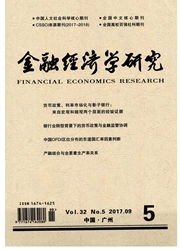

 中文摘要:
中文摘要:
以双阈值机制转移模型刻画通货膨胀周期波动中通胀持久性的变化为基础,使用非线性广义脉冲响应函数分析不同通胀周期阶段随机冲击对通胀的动态冲击效应的实证结果表明:中国的通胀周期可分为通缩持续、通缩缓和、通胀缓和与通胀加速阶段,通胀缓和与通胀加速阶段的通胀持久性相对更高,通缩持续阶段相对较低;2012年7月中国进入新一轮通胀周期的通缩持续阶段,中国刺激经济增长政策对通胀的冲击将由2012年下半年的负向随机冲击转为持续正值。
 英文摘要:
英文摘要:
Based on the inflation persistence in inflation cycle depicted by two thresh-old variable regime-switching, this paper use nonlinear generalized impulse response func-tion to study the dynamic shock effect of inflation shock in different stages of inflation cycle. The results show that: a complete inflation cycle of China can be divided into continuing de- flation stage, deflation easing stage, inflation easing stage, and accelerating inflation stage. The inflation persistence is higher in the inflation easing stage and accelerating inflation stage than in the other stages, and the inflation persistence is the relatively lower in continu-ing deflation stage. The shocks of inflation will be converted to continuous positive from the consecutive negative random shocks in the second half of 2012 with the implementation of the policy to stimulate economic growth in China.
 同期刊论文项目
同期刊论文项目
 同项目期刊论文
同项目期刊论文
 期刊信息
期刊信息
